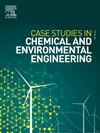The production of leaf bokashi in pilot scale to support zero waste initiative of Universitas Syiah Kuala (USK), Indonesia
Q1 Environmental Science
Case Studies in Chemical and Environmental Engineering
Pub Date : 2024-12-05
DOI:10.1016/j.cscee.2024.101045
引用次数: 0
Abstract
This research aimed to study the effect of bran and husk addition in a pilot-scale leaf bokashi production to support the zero-waste initiative of Universitas Syiah Kuala (USK), Indonesia. The bokashi production was carried out in boxes with a capacity of 50 kg raw materials/box, at the waste bank (BSU) of USK. Bokashi was formulated with 70 % leaves, 20 % cow dung, and 10 % additional ingredients (bran or husk). The quality of the bokashi (bran added bokashi or B bokashi and husk added bokashi or H bokashi) was measured based on the total colony counts (TCC), most probable number (MPN), pH, C, N, C/N ratio, and descriptive organoleptic test. Both types of bokashi were applied to grow corn seeds in 500g-sized polybags and compared to soil media as well as leaf compost media produced by BSU. The test was carried out using a randomized design with one factor and ten replications. The study found that bokashi made with bran outperformed bokashi made with husk and leaf compost of BSU, meeting the Indonesian National Standard for compost quality (SNI 19-7030-2004), and supporting plant growth with improved height, biomass, and greener leaves in corn plants. This bokashi has a TCC of 1.1 × 108 CFU/g, pH of 7.4, C/N ratio of 12.2, and very good descriptive properties (loose texture, earthy scent, and blackish color). This research effectively demonstrates a method that could support USK's zero-waste initiative.
为支持印尼西雅吉隆坡大学(USK)的零废物倡议,以中试规模生产薄荷叶
本研究旨在研究添加麸皮和谷壳对中试规模的薄荷叶生产的影响,以支持印度尼西亚锡亚吉隆坡大学(USK)的零废物倡议。在USK的废物银行(BSU), bokashi生产是在容量为50公斤原材料/箱的箱子中进行的。Bokashi由70%的叶子,20%的牛粪和10%的其他成分(麸皮或外壳)组成。根据菌落总数(TCC)、最可能菌落数(MPN)、pH、C、N、C/N比和描述性感官试验来衡量bokashi(麸皮加bokashi或B bokashi,壳加bokashi或H bokashi)的质量。两种类型的bokashi被用于种植玉米种子在500克大小的塑料袋,并与土壤介质和BSU生产的叶片堆肥介质进行比较。试验采用1因子、10个重复的随机设计。研究发现,用麸皮制成的bokashhi优于用BSU的壳叶堆肥制成的bokashhi,符合印尼国家堆肥质量标准(SNI 19-7030-2004),并且在玉米植株中支持植物生长,提高了植株的高度、生物量和叶片。该bokashi的TCC为1.1 × 108 CFU/g, pH值为7.4,C/N比为12.2,具有很好的描述性(质地疏松,泥土气味,颜色偏黑)。这项研究有效地展示了一种可以支持USK零废物倡议的方法。
本文章由计算机程序翻译,如有差异,请以英文原文为准。
求助全文
约1分钟内获得全文
求助全文
来源期刊

Case Studies in Chemical and Environmental Engineering
Engineering-Engineering (miscellaneous)
CiteScore
9.20
自引率
0.00%
发文量
103
审稿时长
40 days
 求助内容:
求助内容: 应助结果提醒方式:
应助结果提醒方式:


